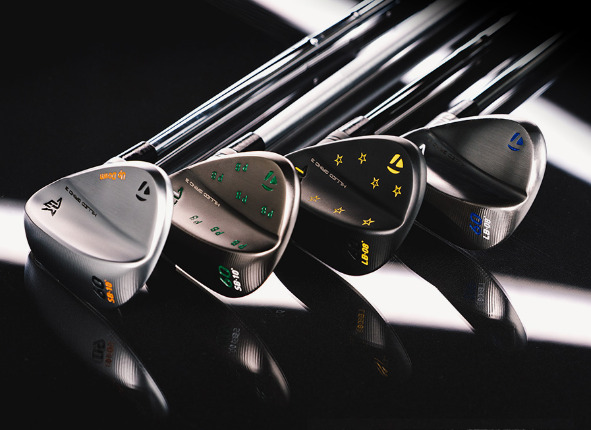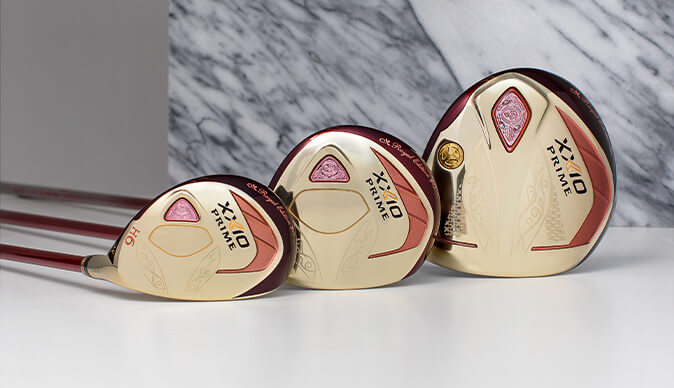What is a wedge in golf?
Golf is a sport full of finesse, strategy, and a wide variety of specialized clubs designed to help you navigate the course and improve your game.
One such specialized club is the wedge, a club with a high loft and a unique design to help golfers tackle specific challenges.
In this article, we’ll discuss everything you need to know about wedges in golf, from their purpose and types to selecting the right one for your game. Let’s dive in!
What is a Wedge in Golf?
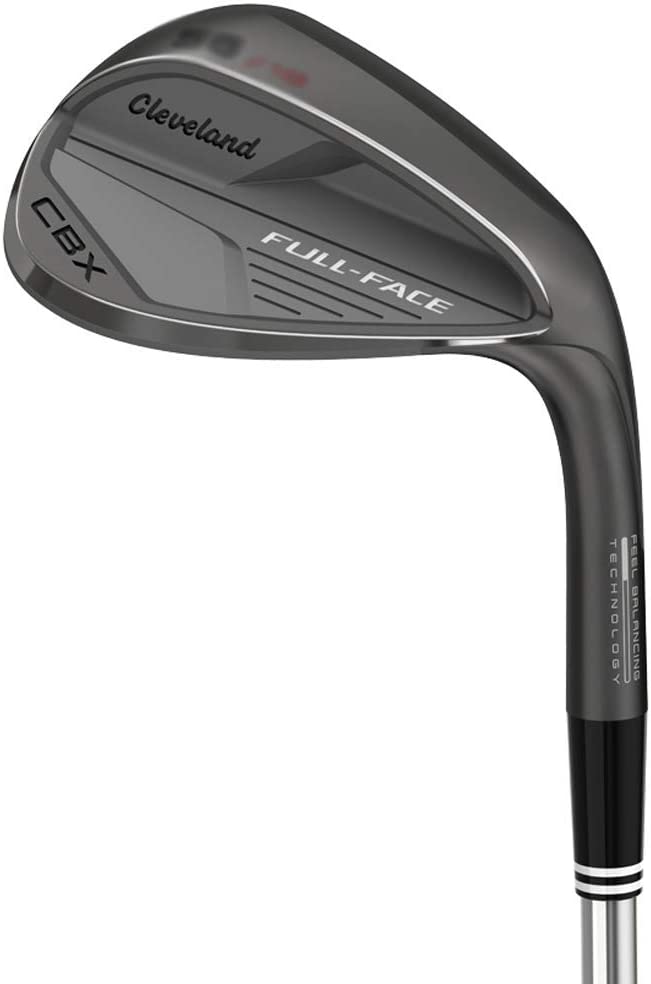
Image credit: Cleveland Golf.
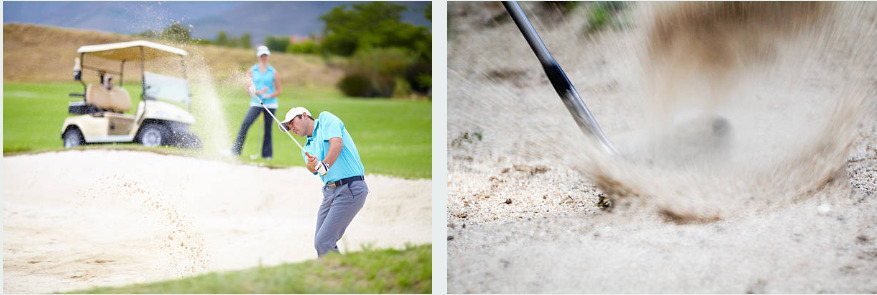
A wedge is a type of golf club that is designed to help golfers hit shots with a high trajectory and a short distance. Wedges are typically used for shots that require precision and accuracy, such as pitching, chipping, and bunker shots.
Wedges are characterized by their high loft, which is the angle between the clubface and the ground. The higher the loft, the higher the ball will fly and the shorter the distance it will travel.
Wedges have lofts ranging from 46 to 64 degrees, with the most common lofts being 52, 56, and 60 degrees.
- Pitching Wedge (PW)
- Gap Wedge (GW)
- Sand Wedge (SW)
- Lob Wedge (LW)
Pitching Wedge (PW).
The pitching wedge is the most common and versatile of all the wedges. It typically has a loft between 44 and 48 degrees and is used for a wide range of short-game shots, such as approach shots, chips, and pitches.
A skilled golfer can achieve a variety of shot heights and distances with a pitching wedge, making it an essential club in any golfer’s bag.
Let’s look at the characteristics, purpose, and techniques associated with the pitching wedge.
Characteristics of the Pitching Wedge.
The pitching wedge is characterized by its loft, which typically ranges between 44 and 48 degrees. This loft, combined with its moderate bounce angle and versatile sole grind, allows for various shot types.
The pitching wedge’s design enables golfers to achieve both height and spin on their shots, making it a go-to club for various situations on the course.
Purpose of the Pitching Wedge.
The primary purpose of the pitching wedge is to provide golfers with a club that excels in short-game situations.
It’s particularly useful for approach shots, chips, and pitches, where control and accuracy are of the utmost importance.
Due to its versatility, the pitching wedge can be used to execute a wide range of shots, such as full swings, partial swings, and even delicate chips around the green.
Techniques for Using the Pitching Wedge Effectively.
To get the most out of your pitching wedge, it’s crucial to adopt proper techniques that ensure consistent and accurate shots. Here are some tips to keep in mind:
- Stance: Adopt a slightly narrower stance than you would with longer clubs, and position the ball in the center of your stance. This stance promotes better control and balance when swinging the pitching wedge.
- Grip: Use a firm but relaxed grip on the club, with your hands slightly down the grip to improve control and feel.
- Swing Tempo: Maintain a smooth, controlled swing tempo throughout the entire swing. This consistency helps ensure solid contact with the ball and reduces the chances of mishits.
- Weight Transfer: Proper weight transfer during the swing is essential for generating power and control. As you swing, shift your weight from your back foot to your front foot, ensuring a balanced and stable finish.
- Follow-Through: A confident follow-through is crucial for maintaining the proper swing path and ensuring consistent shots. After making contact with the ball, allow your arms and club to continue their natural motion, finishing with your weight on your front foot and the club pointing toward the target.
Gap Wedge (GW).
The gap wedge, also known as the approach wedge, is designed to bridge the gap between the pitching wedge and the sand wedge.
It is a valuable addition to a golfer’s bag, providing a solution for shots that fall between the pitching wedge and sand wedge.
Characteristics of the Gap Wedge.
It typically has a loft between 50 and 54 degrees, which makes it ideal for shots between 80 and 110 yards. This wedge is perfect for situations where a pitching wedge might be too strong, but a sand wedge would come up short.
This loft, along with a moderate bounce angle and versatile sole grind, enables golfers to achieve an ideal balance of height and spin on their shots. The gap wedge’s design ensures consistent performance and accuracy in various short-game situations.
Purpose of the Gap Wedge.
The primary purpose of the gap wedge is to bridge the distance gap between the pitching wedge and sand wedge, allowing golfers to execute shots that require a specific trajectory and distance.
It’s particularly useful for approach shots and greenside chipping, where precision and control are crucial. With its unique loft and design, the gap wedge fills an essential role in any golfer’s short-game arsenal.
Techniques for Using the Gap Wedge Effectively.
To maximize the performance of your gap wedge, it’s essential to employ proper techniques that ensure consistent and accurate shots. Here are some tips to keep in mind:
- Stance: Adopt a slightly narrower stance than you would with longer clubs and position the ball in the center of your stance. This stance promotes better control and balance when swinging the gap wedge.
- Grip: Use a firm but relaxed grip on the club, with your hands slightly down the grip for improved control and feel.
- Swing Tempo: Maintain a smooth, controlled swing tempo throughout the entire swing. This consistency helps ensure solid contact with the ball and reduces the chances of mishits.
- Weight Transfer: Proper weight transfer during the swing is essential for generating power and control. As you swing, shift your weight from your back foot to your front foot, ensuring a balanced and stable finish.
- Follow-Through: A confident follow-through is crucial for maintaining the proper swing path and ensuring consistent shots. After making contact with the ball, allow your arms and club to continue their natural motion, finishing with your weight on your front foot and the club pointing toward the target.
Sand Wedge (SW).
As the name implies, the sand wedge is designed specifically for getting your ball out of sand traps. It has a loft between 54 and 58 degrees and features a wide sole with a high bounce, which helps the club glide through the sand and lift the ball out of the bunker. However, its uses are not limited to sand; it can also be effective in thick grass and other challenging lies.
Characteristics of the Sand Wedge.
The sand wedge is characterized by its loft, bounce, and grind, which are specifically designed to perform in the sand and other difficult lies. Here’s a closer look at these characteristics:
- Loft: The loft of a sand wedge typically ranges between 54 and 58 degrees, providing the necessary height and spin for escaping bunkers and executing high, soft-landing shots.
- Bounce: The bounce of a sand wedge refers to the angle between the leading edge of the clubface and the lowest point of the sole. This angle helps prevent the club from digging too deep into the sand or turf. Sand wedges usually have a higher bounce angle compared to other wedges, making them more effective in soft conditions or bunkers.
- Grind: The grind of a sand wedge refers to the shaping of the sole. Different grinds offer varying levels of versatility and playability based on the golfer’s swing and course conditions. A suitable grind for a sand wedge is one that allows for easy interaction with the sand and turf, enabling golfers to execute a wide range of shots.
Purpose of the Sand Wedge
The primary purpose of the sand wedge is to help golfers escape bunkers and handle other challenging short-game situations, such as deep rough or tight lies. Its design allows for the necessary height and spins to get the ball up and out of difficult positions, as well as to land softly on the green. The sand wedge is an invaluable tool for golfers looking to improve their short-game performance and save strokes around the green.
Techniques for Using the Sand Wedge Effectively
To maximize the performance of your sand wedge, it’s essential to employ proper techniques that ensure consistent and accurate shots. Here are some tips to keep in mind:
- Stance: Adopt a slightly open stance with your feet wider than shoulder-width apart. This stance promotes stability and allows for better weight transfer during the swing.
- Grip: Use a firm but relaxed grip on the club, with your hands slightly down the grip for improved control and feel.
- Ball Position: For bunker shots, position the ball slightly forward in your stance to promote a higher launch. For other short-game shots, position the ball in the center of your stance.
- Swing Tempo: Maintain a smooth, controlled swing tempo throughout the entire swing. This consistency helps ensure solid contact with the ball and reduces the chances of mishits.
- Weight Transfer: Proper weight transfer during the swing is essential for generating power and control. As you swing, shift your weight from your back foot to your front foot, ensuring a balanced and stable finish.
Lob Wedge (LW).
The lob wedge is the highest lofted wedge and is a specialized club designed for executing high, soft-landing shots around the green and in other challenging short-game situations.
with a loft between 58 and 64 degrees, making it perfect for achieving maximum height and spin on the ball. This wedge is ideal for situations that require delicate touch and finesse, such as hitting over obstacles, tight lies, or executing flop shots.
While it may be more challenging to master, it’s an invaluable tool for skilled golfers looking to improve their short game.
Characteristics of the Lob Wedge.
The lob wedge is characterized by its loft, bounce, and grind, which are specifically designed to perform in a variety of short-game situations. Here’s a closer look at these characteristics:
- Loft: The loft of a lob wedge typically ranges between 58 and 64 degrees, providing the necessary height and spin for hitting high, soft-landing shots that stop quickly on the green.
- Bounce: The bounce of a lob wedge refers to the angle between the leading edge of the clubface and the lowest point of the sole. This angle helps prevent the club from digging too deep into the turf or sand. Lob wedges usually have a moderate to low bounce angle, making them versatile and suitable for a variety of course conditions.
- Grind: The grind of a lob wedge refers to the shaping of the sole. Different grinds offer varying levels of versatility and playability based on the golfer’s swing and course conditions. A suitable grind for a lob wedge is one that allows for easy interaction with the turf and sand, enabling golfers to execute a wide range of shots.
Purpose of the Lob Wedge.
The primary purpose of the lob wedge is to help golfers execute high, soft-landing shots in challenging short-game situations, such as hitting over obstacles, tight lies, or executing flop shots. Its design allows for the necessary height and spin to get the ball up quickly and land softly on the green.
A lob wedge is an invaluable tool for golfers looking to improve their short-game performance and save strokes around the green.
Techniques for Using the Lob Wedge Effectively.
To maximize the performance of your lob wedge, it’s essential to employ proper techniques that ensure consistent and accurate shots. Here are some tips to keep in mind:
- Stance: Adopt a slightly open stance with your feet shoulder-width apart. This stance promotes stability and allows for better weight transfer during the swing.
- Grip: Use a firm but relaxed grip on the club, with your hands slightly down the grip for improved control and feel.
- Ball Position: Position the ball slightly forward in your stance to promote a higher launch angle and a softer landing.
- Swing Tempo: Maintain a smooth, controlled swing tempo throughout the entire swing. This consistency helps ensure solid contact with the ball and reduces the chances of mishits.
- Weight Transfer: Proper weight transfer during the swing is essential for generating power and control. As you swing, shift your weight from your back foot to your front foot, ensuring a balanced and stable finish.
Choosing the Right Wedge for Your Game.
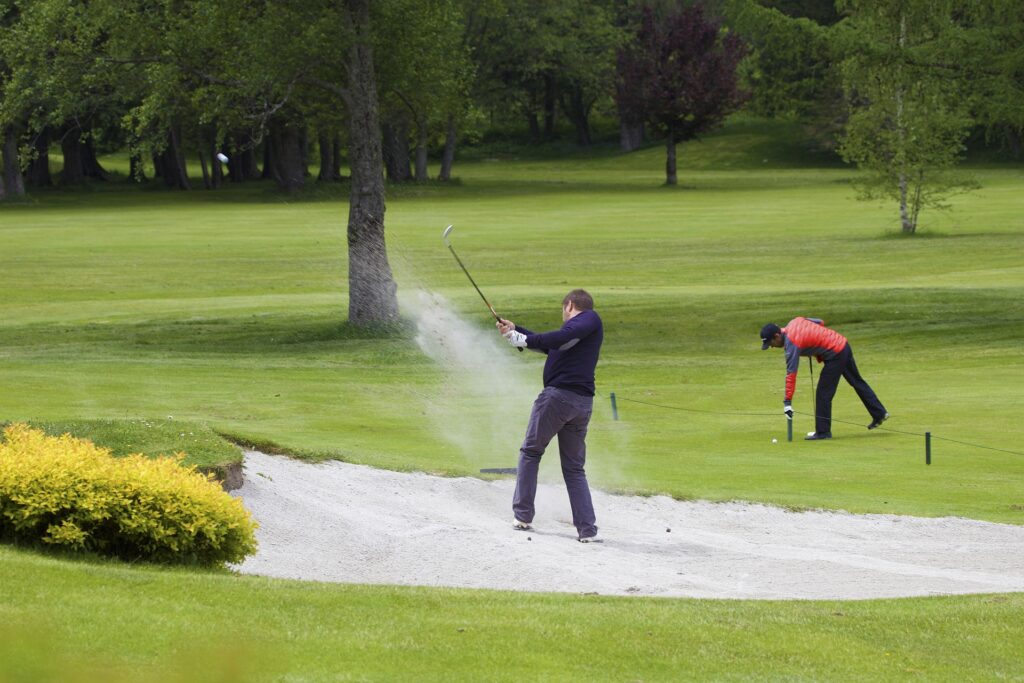
Selecting the right wedges for your golf game is essential for optimizing your short-game performance and lowering your scores.
Let’s look at the factors to consider when choosing the right wedges, ensuring you make an informed decision that suits your individual needs and playing style.
1. Assess Your Skill Level and Playing Style.
Before selecting the right wedges, it’s essential to evaluate your skill level and playing style. Beginners and high handicappers may benefit from a more straightforward wedge setup, such as having a pitching wedge (PW) and sand wedge (SW) in their bag.
More advanced players with a refined short game may want to consider adding a gap wedge (GW) and lob wedge (LW) to their arsenal for increased versatility and shot-making options.
2. Consider the Loft.
The loft of a wedge determines its trajectory and distance. When selecting wedges, it’s crucial to ensure there are consistent loft gaps between each club to cover various distances effectively. A typical setup may include:
- Pitching wedge (PW): 44-48 degrees
- Gap wedge (GW): 50-54 degrees
- Sand wedge (SW): 54-58 degrees
- Lob wedge (LW): 58-64 degrees
Ensure that the loft gaps between your wedges are consistent (usually 4-6 degrees) to provide a smooth transition between clubs and avoid any significant distance gaps.
3. Evaluate the Bounce.
The bounce of a wedge refers to the angle between the leading edge of the clubface and the lowest point of the sole.
Bounce is crucial for determining how a wedge interacts with the turf or sand. Golfers should consider their typical playing conditions and swing characteristics when selecting the appropriate bounce for their wedges:
- Low bounce (4-6 degrees): Suitable for firm turf conditions, tight lies, and players with a shallow swing or who tend to sweep the ball.
- Mid bounce (7-10 degrees): Versatile for a variety of playing conditions and swing types.
- High bounce (10+ degrees): Ideal for soft turf conditions, fluffy sand, and players with a steeper swing or who tend to dig into the ground.
4. Examine the Grind
The grind of a wedge refers to the shaping of the sole, which can affect its versatility and playability. Different grinds are suitable for various swing types and course conditions:
- Standard grind: Offers a balance of versatility and playability for most golfers.
- Heel grind: Provides relief in the heel area, allowing for increased versatility in open-faced shots.
- Wide sole grind: Offers additional forgiveness and ease of use, especially in bunkers and soft conditions.
Choose a grind that complements your swing and the typical course conditions you encounter.
5. Test Various Wedges.
Once you have a general idea of the wedge specifications you need, it’s essential to test various wedges to determine which ones feel and perform the best for your game. Visit a local golf retailer or demo day to try out different brands, models, and configurations to find the perfect match.
Wedge Gapping and Loft.
Gapping is the process of ensuring that there are consistent distance intervals between each club in your bag. Proper gapping helps you avoid situations where you’re left without the appropriate club for a specific shot.
To ensure proper gapping, pay attention to the loft of your wedges and how they fit within your overall club setup.
Wedge gapping and loft play a crucial role in optimizing your short-game performance. By understanding the importance of consistent loft gaps between wedges and selecting the appropriate lofts for your game, you can improve your shot-making capabilities and ultimately lower your scores.
In this article, we’ll discuss the concept of wedge gapping and the significance of loft in maximizing your short-game potential.
Wedge Gapping: The Key to Versatility.
Wedge gapping refers to the consistent spacing of lofts between your wedges, ensuring a smooth transition between clubs and providing a reliable distance progression.
Proper wedge gapping allows golfers to execute a wide range of shots with precision and confidence, enabling them to tackle various short-game situations effectively.
Understanding Loft.
Loft is the angle of the clubface relative to the shaft, determining the trajectory and distance of a golf shot. In the context of wedges, higher-lofted clubs produce higher, shorter shots with more spin, while lower-lofted clubs generate lower, longer shots with less spin.
Loft Recommendations for a Balanced Wedge Set.
To create a balanced wedge set, consider the following loft recommendations:
- Pitching Wedge (PW): 44-48 degrees – The pitching wedge is typically the lowest lofted wedge in your bag, providing a balance of distance and trajectory for full shots and basic pitch shots around the green.
- Gap Wedge (GW): 50-54 degrees – The gap wedge bridges the distance gap between the pitching wedge and sand wedge, offering increased versatility for a variety of short game shots, such as chips, pitches, and longer bunker shots.
- Sand Wedge (SW): 54-58 degrees – The sand wedge is designed primarily for bunker play and challenging short-game situations. Its loft enables high, soft-landing shots, while its bounce and grind characteristics make it suitable for various course conditions and lies.
- Lob Wedge (LW): 58-64 degrees – The lob wedge is the highest lofted club in most golfer’s bags, designed for executing high, soft-landing shots that stop quickly on the green. It’s particularly useful for flop shots, tight lies, and shots over obstacles.
A common approach is to maintain a consistent loft gap of 4-6 degrees between each wedge, ensuring a smooth transition between clubs and a reliable distance progression.
Customizing Your Wedge Set.
While the recommendations above provide a general guideline for a balanced wedge set, it’s essential to tailor your wedge selection to your skill level, playing style, and typical course conditions.
Beginners and high handicappers may benefit from a simpler wedge setup, while more advanced players may want to fine-tune their wedge lofts for specific shot-making requirements or course conditions.
How to Calculate Loft.
Loft refers to the angle of the clubface relative to the shaft. To calculate the loft, measure the angle between the clubface and a vertical line running through the center of the shaft. This will help you determine the lofts of your current wedges and identify any gaps that may need to be filled.
Techniques for Using Wedges Effectively.
To maximize your short-game performance, it’s essential to understand and practice effective techniques for using wedges.
In this section, we’ll discuss key techniques to help you gain confidence and precision when using your wedges, ultimately leading to lower scores and improved consistency on the course.
1. Proper Stance and Setup
A solid foundation is crucial for executing accurate wedge shots. Adopt a slightly open stance with your feet shoulder-width apart, promoting stability and allowing for better weight transfer during the swing.
Position the ball slightly back in your stance for lower lofted wedges (PW, GW) and more centrally for higher lofted wedges (SW, LW). This ball position helps ensure consistent contact and promotes the desired trajectory for each wedge.
2. Grip and Clubface Control
Use a firm but relaxed grip on the club, with your hands slightly down the grip for improved control and feel. Ensure your clubface is square at address, and maintain control of the clubface throughout the swing, as this greatly influences the trajectory and spin of your shots.
3. Swing Tempo and Rhythm.
Maintain a smooth, controlled swing tempo throughout the entire swing. Consistency in your tempo helps ensure solid contact with the ball and reduces the chances of mishits. Focus on accelerating through impact and maintaining a balanced finish, as this promotes consistent trajectory and distance control.
4. Weight Transfer and Body Rotation.
Proper weight transfer and body rotation are critical for generating power and control in your wedge shots. As you swing, shift your weight from your back foot to your front foot, while rotating your hips and shoulders through impact. This weight transfer and rotation provide the necessary force and control to execute accurate and consistent wedge shots.
5. Practice Various Shot Types.
Wedges are versatile clubs that can be used for a wide range of short game shots, such as chips, pitches, flops, and bunker shots.
Dedicate practice time to working on each type of shot, developing a feel for the different techniques and adjustments required for each situation. This versatility will allow you to tackle any short game challenge with confidence.
6. Develop Your Touch and Feel
Developing touch and feel around the greens is a crucial aspect of effective wedge play. Spend time on the practice green, working on shots from various distances and lies. Focus on controlling distance, trajectory, and spin to hone your skills and develop a better understanding of how each wedge performs in different situations.
7. Course Management and Strategy.
Effective wedge play also involves smart course management and strategy. Evaluate each short game situation carefully, taking into account factors such as lie, wind, green conditions, and pin position. Select the appropriate wedge and shot type for each situation, maximizing your chances of success and minimizing risk.
Wedge Maintenance and Care.
To keep your wedges in top condition, clean them regularly to remove dirt and debris from the grooves. Inspect the clubface for wear and tear, and consider regrooving or replacing your wedges as needed to maintain optimal performance.
Common Mistakes When Using Wedges.
Avoid these common mistakes when using wedges:
- Over-swinging: Trying to hit the ball too hard can lead to poor contact and
- inconsistency. Focus on a smooth, controlled swing. 2. Decelerating through impact: Maintain your swing speed through the ball for better contact and control.
- Incorrect ball position: Ensure the ball is positioned correctly in your stance for the type of shot you’re attempting.
- Poor weight transfer: Shift your weight from your back foot to your front foot during the swing for better balance and power.
Top Wedge Brands
Several brands are well-known for producing high-quality wedges, including:
- Titleist (Vokey Design)
- Callaway (Mack Daddy series)
- TaylorMade (MG series)
- Cleveland (RTX series)
- Ping (Glide series)
Each brand offers a range of options to cater to different golfer preferences and skill levels.
FAQs.
Here are some of the frequently most asked questions on golf wedges and our answers. I hope these answers addressed some of your basic worries.
How many wedges should I carry in my golf bag?
Most golfers carry three to four wedges, but this can vary depending on personal preference and skill level.
What is the difference between a gap wedge and a pitching wedge?
The main difference is the loft angle. A gap wedge has a higher loft angle than a pitching wedge, making it ideal for shots that require more height and spin.
How do I know when it’s time to replace my wedges?
If you notice decreased spin, control, or consistency in your wedge shots, it may be time to regroove or replace your wedges.
How often should I clean my wedges?
Ideally, you should clean your wedges after every round of golf to remove dirt and debris from the grooves and maintain optimal performance.
What is the purpose of a lob wedge?
A lob wedge is designed for high-lofted shots that require precision and touch, such as hitting over obstacles, tight lies, or executing flop shots.
Conclusion.
In conclusion, wedges are an essential part of any golfer’s bag and are used for a variety of shots around the green.
Understanding the role of wedges in golf and how to use them effectively is essential for improving your short game.
By selecting the right wedge for your needs, mastering proper technique, and maintaining your clubs, you’ll be better equipped to tackle the challenges of the course and lower your scores.

